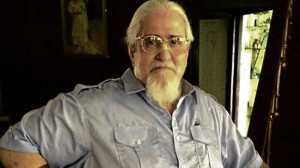
PEQUE Gallaga recreated some 15 paintings by Botong with the help of actors who reenacted iconic scenes. Photo by Bayani San Diego jr.
It must have been fated that these two artists should cross paths at some point.
Peque Gallaga—acclaimed filmmaker behind 1980s classics “Oro, Plata, Mata,” “Virgin Forest” and “Scorpio Nights”— was commissioned by the Ayala Foundation Inc. to make a documentary on the late National Artist, muralist Carlos “Botong” Francisco.
It was serendipitous because, like Francisco, Gallaga had his start in the film industry as a production designer.
Francisco designed the costumes in movies like Manuel Conde’s “Genghis Khan,” “Siete Infantes de Lara,” and the “Juan Tamad” series.
These epics coincidentally left an indelible mark on Gallaga as a child growing up on Carolina Street in Malate, Manila, in the 1950s.
Art form
“As a kid, I used to sneak into a moviehouse near the Manila Zoo and watch all those costume swashbuckler movies,” Gallaga recalled.
When the restored “Genghis Khan” (one of those movies) premiered at the SM Mall of Asia recently, Gallaga and Lore Reyes, the Botong docu’s line producer, made sure to grace the occasion.
Between serving as consultant in the digital restoration of “Oro, Plata, Mata” and shooting his Regal comeback, “Seduction” (with Richard Gutierrez, Sarah Labati and Solenn Heussaff), Gallaga found the time to make the Botong film.
He considers the documentary as the most exciting art form in Philippine cinema today. “Filmmakers Ditsi Carolino, Jay Abello and Monster Jimenez and Mario Cornejo are creating fantastic docus,” he said.
He surmised that the Ayala group selected him to direct the docu precisely because of his movie background.
Most cinematic
“Botong is the most cinematic among Filipino painters,” explained Gallaga, who had previously directed a docu on an ancestral house in Quiapo, “Bahay Nakpil-Bautista.”
As an example of Francisco’s filmic flair, he cited the painter’s masterpiece “The Martyrdom of Jose Rizal.”
“A white spirit is flowing around Rizal, but that can also be the shock waves of the bullet. There’s a lot of movement in his works,” said Gallaga.
He recreated “15 or so paintings by Botong” in the docu with the help of actors who reenacted historic and iconic scenes on a green screen.
Lance Raymundo, who was cast as pre-Hispanic warrior Lapu-Lapu, is the only known name in the ensemble. “We got mostly talents who were usually relegated as extras in movies. We needed real Pinoys who were not into Glutathione pills and other skin-whitening products.”
He cast three actors to play Francisco for various scenes.
While Gallaga was doing research in Francisco’s hometown of Angono, Rizal, an old-timer admonished him: “Botong was as dark as Vice President Jejomar Binay.”
Romanticized Pinoy
Thus, Gallaga had to turn one fair-skinned “Botong” actor into a moreno, aided by the high-tech wizardry of color-grading experts.
“Botong presented a romanticized and heroic image of the Filipino in his works,” Gallaga said. “Botong painted Filipinos the way they saw themselves, brown-skinned and beautiful. Until now, the whole of Angono is proud of Botong.”
The toughest segment proved to be the one on the painting, “Bayanihan.” The filmmaker elaborated: “Botong played with perspective and with the human body itself in the painting. Half of the anatomy was done from a lower perspective, while the other half was from a higher angle for dramatic impact. It’s like shooting with three cameras from different heights and merging the form into one character. It’s almost physically impossible to recreate. It was quite a challenge.”
P4-M budget
Reyes disclosed that the budget for the project was P4 million. “The docu is going through three months of post-production,” he said.
Gallaga hopes to unveil “Images of Nation: Botong Francisco,” in time for a major exhibit of the artist’s works at the Ayala Museum on December 7. This year marks the centennial of Francisco’s birth. (He was born on November 4.)
While working on the docu, Gallaga said he was reminded that our elders paved the way for succeeding generations of artists.
“Younger artists think their works are great and important,” he said, pointing out that the docu was a lesson in humility. “Indeed, we are standing on the shoulders of giants. These pioneers ventured into forbidden terrain, celebrating Filipino heritage at a time when Western culture dominated the scene.”
(bayanisandiegojr@gmail.com)